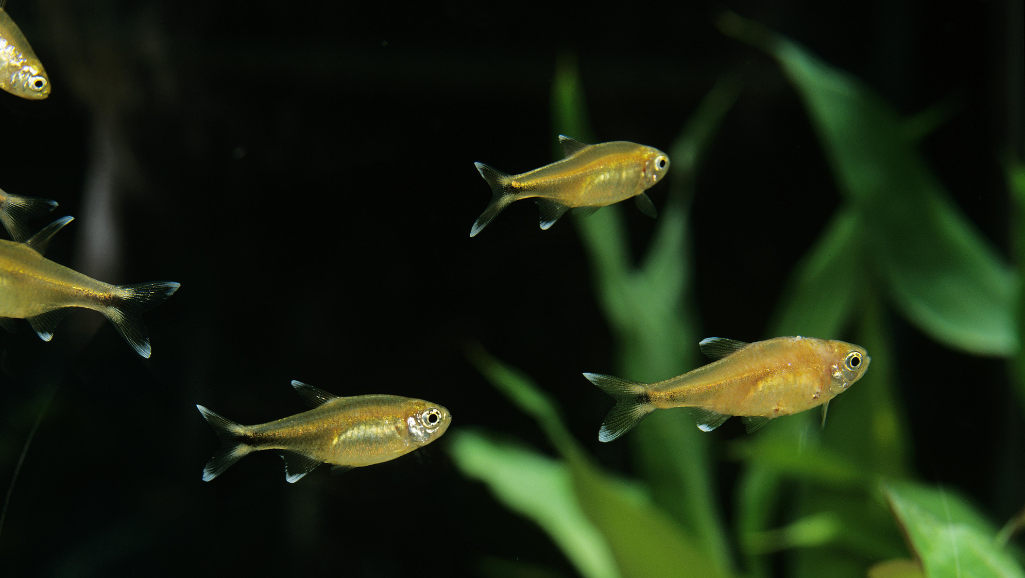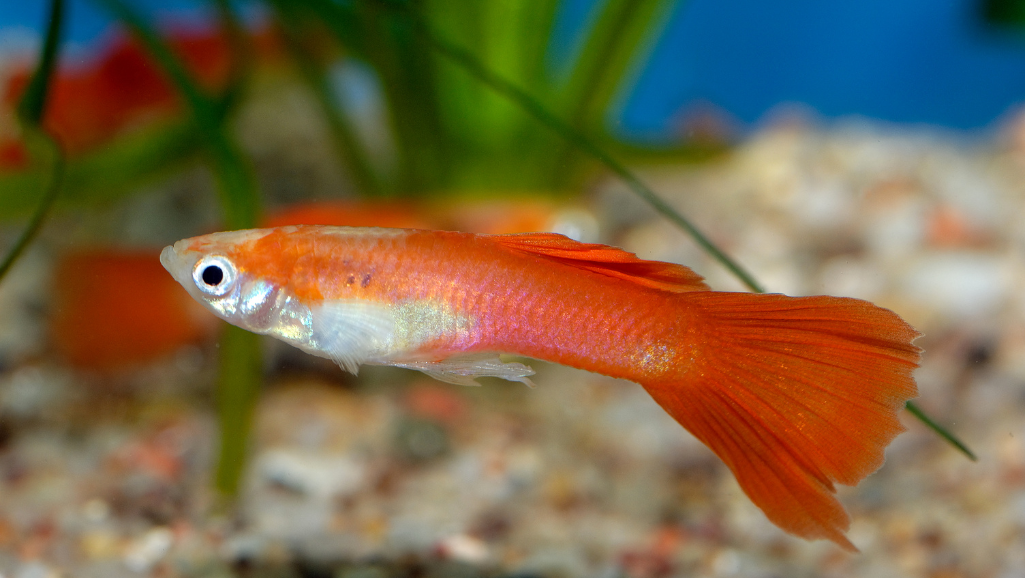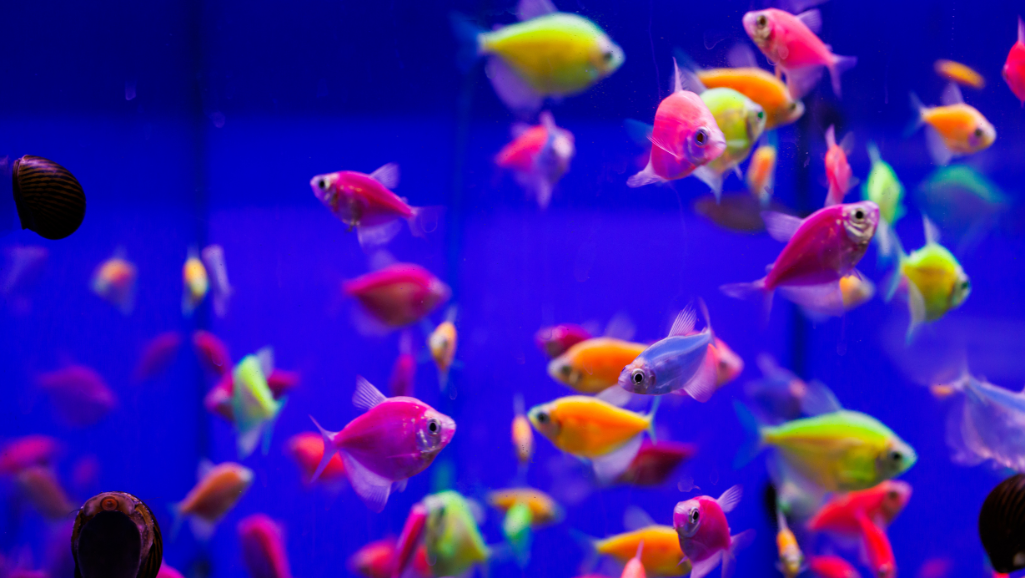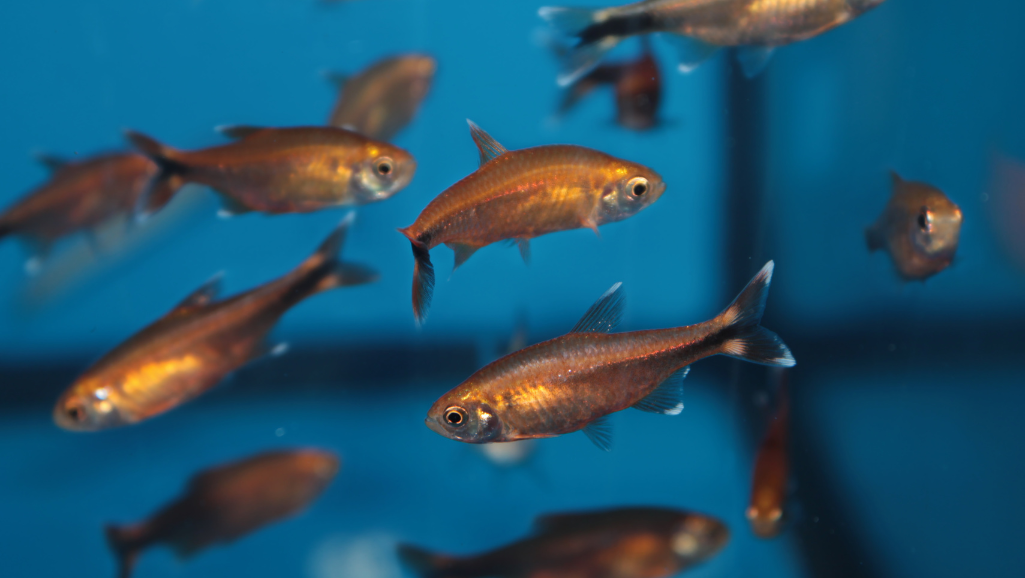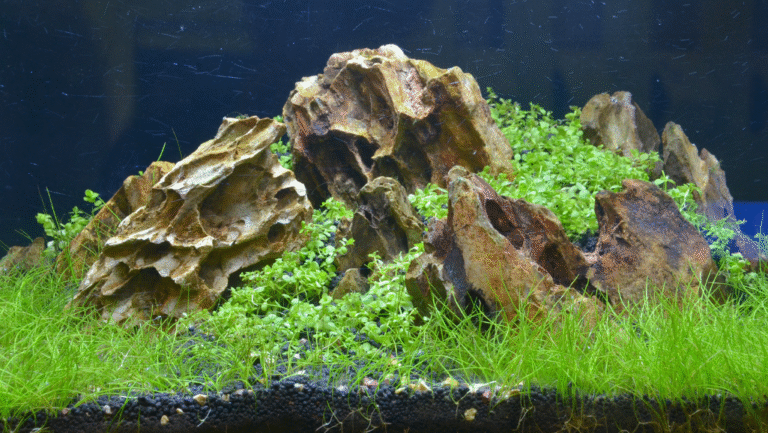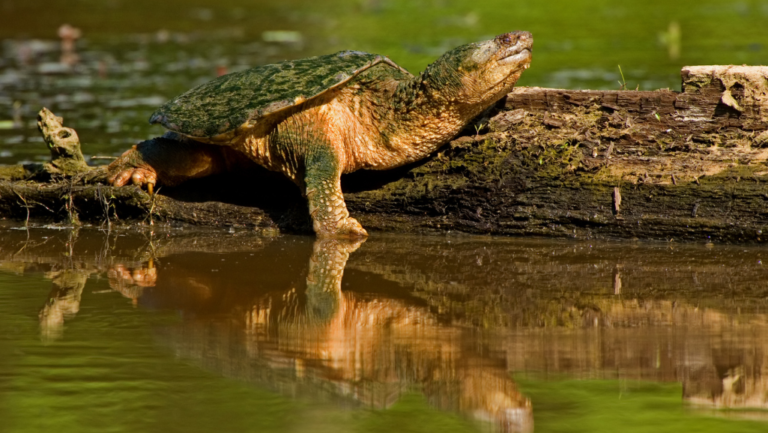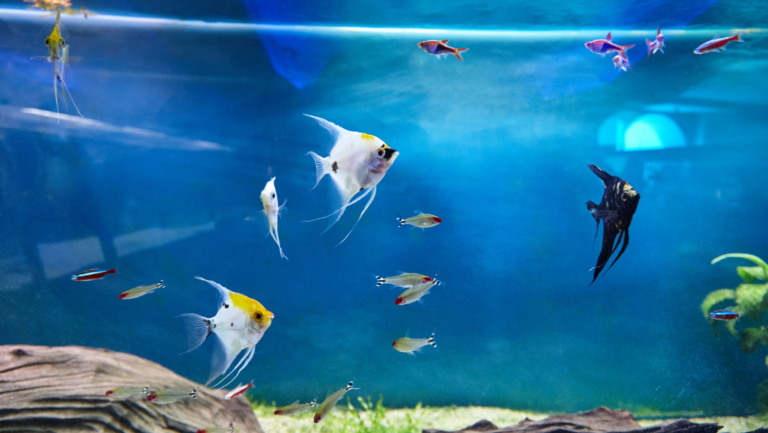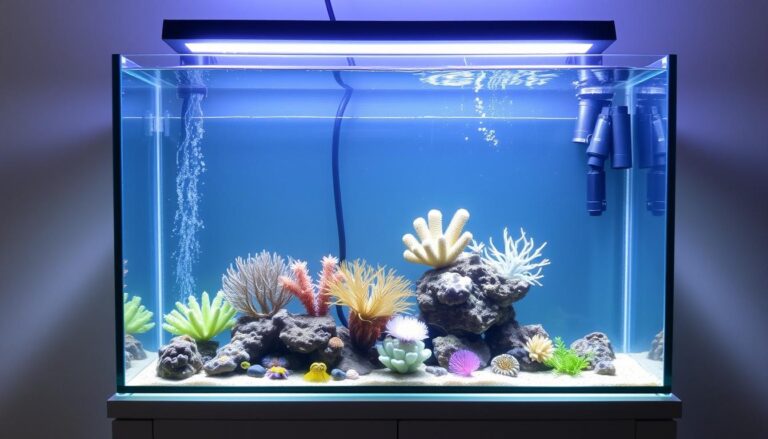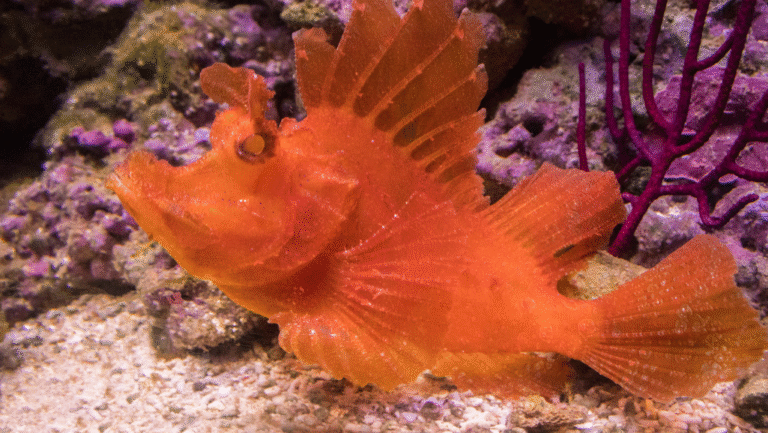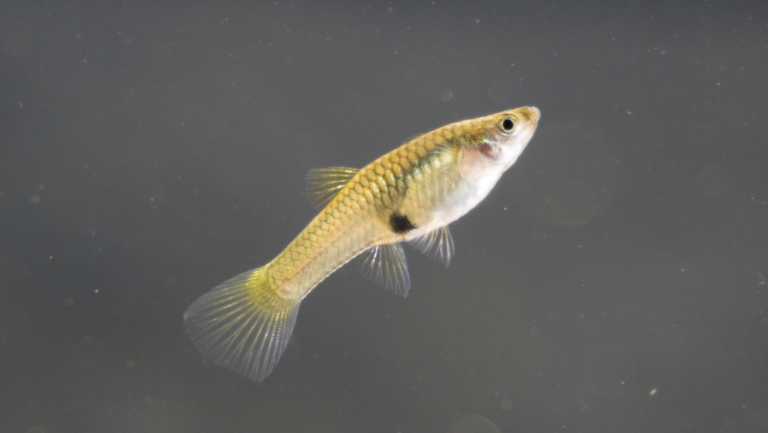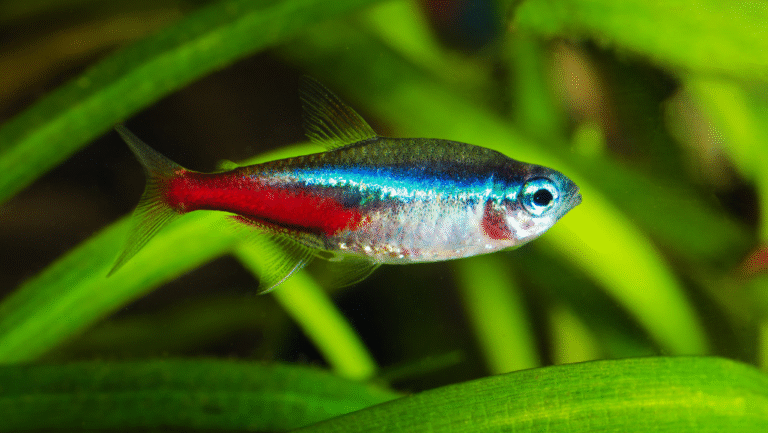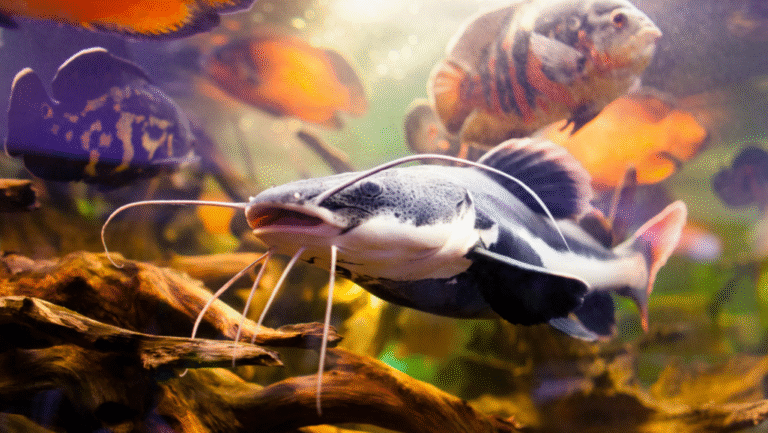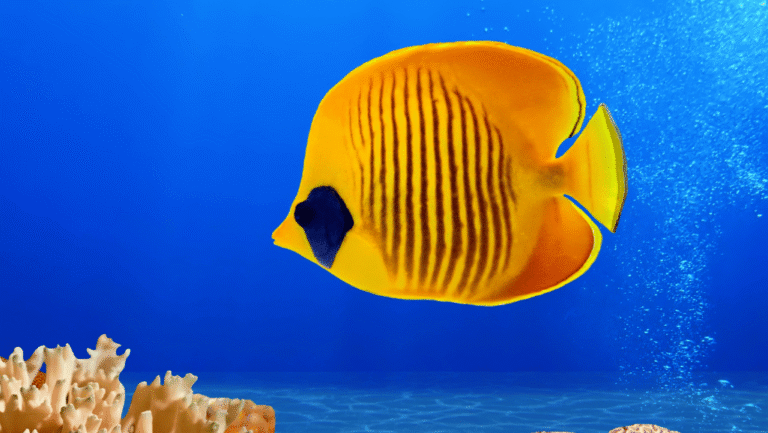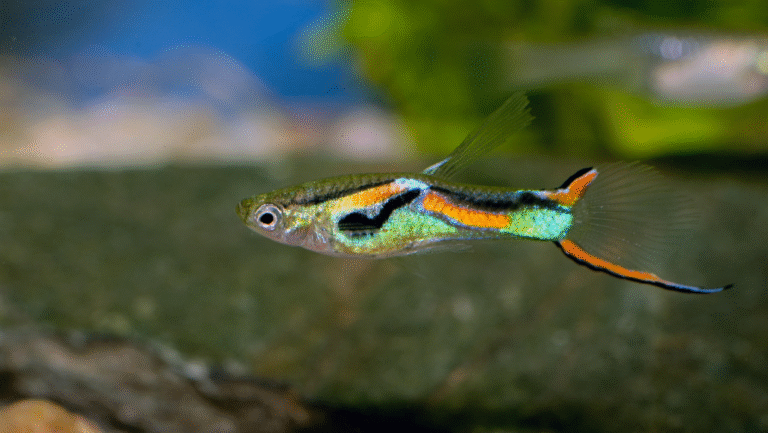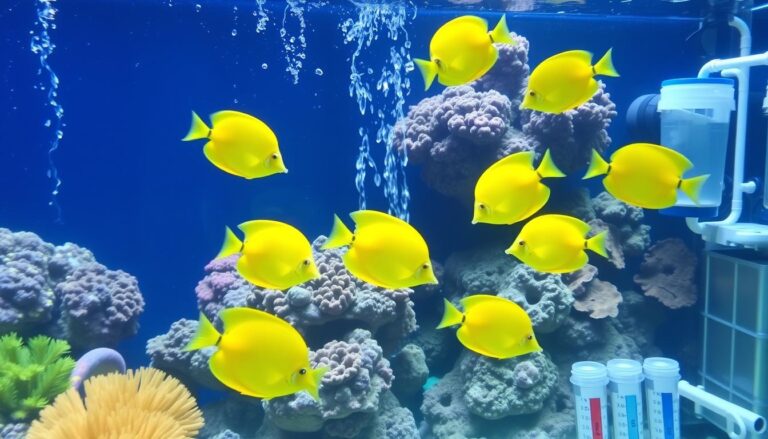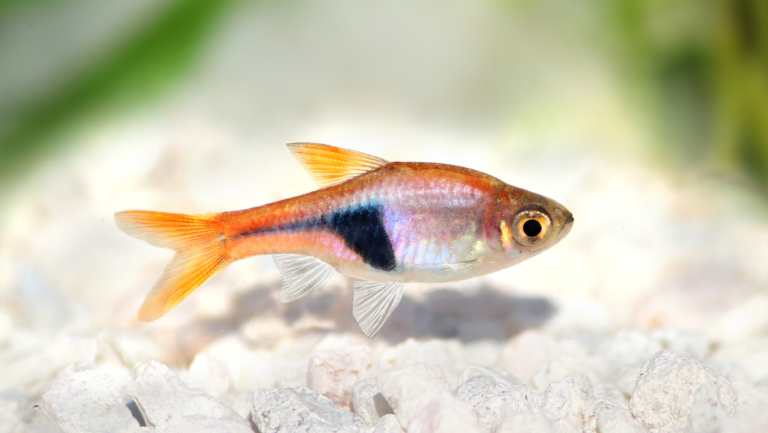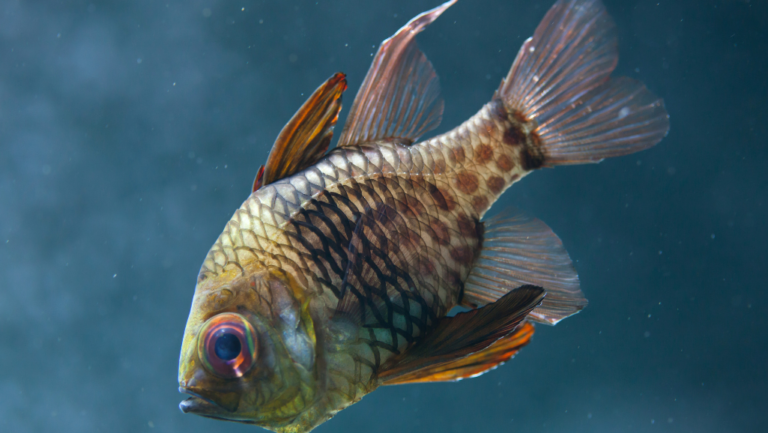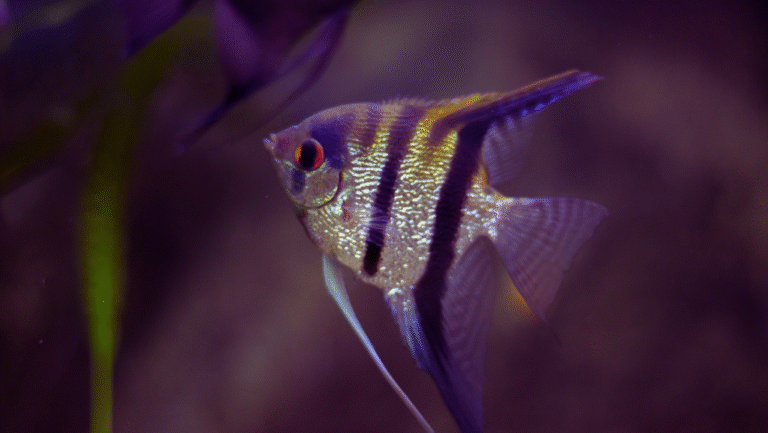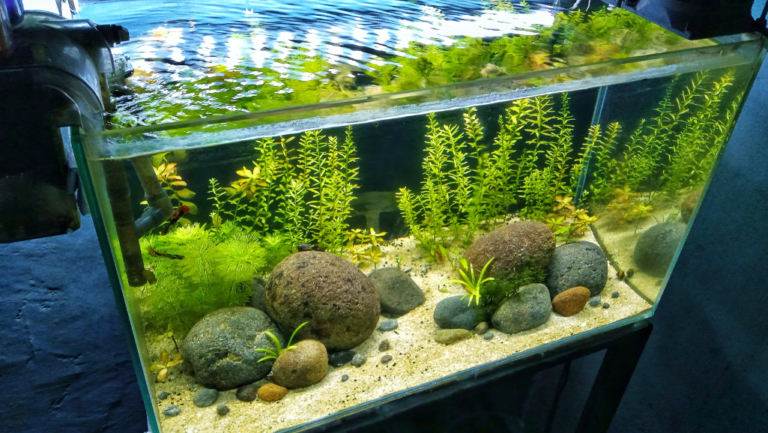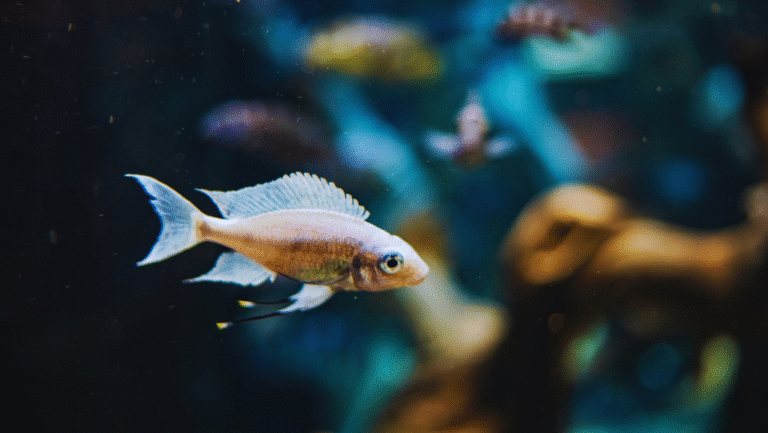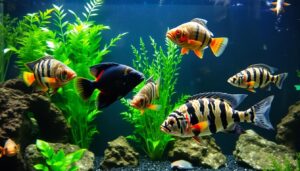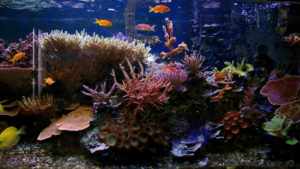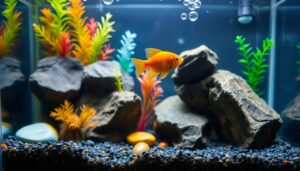Step into a gallery of motion. From long-finned bettas to regal discus, these elegant species turn any aquarium into living art. Each name on this list shows how fins, body shape, and color combine to create mesmerising movement.
We’ll preview key care and tank notes so you can match the right creature to the right space. Expect quick cues on size, temperature, and companions to help your display stay calm and vivid.
Whether you favor a statement single or a coordinated school, you’ll learn which fish species suit nano tanks and which need room to shine. Practical tips cover gentle filtration, Flowy Fish, and compatible mates to keep beauty and balance.
Use this guide to plan an aquarium that flows with life. With a few smart choices, your setup can deliver years of graceful motion and bold colors.
Key Takeaways
- Match tank size to species needs: nano tanks work for some, large tanks suit discus and schools.
- Temperature and stable water are vital—Discus need warmer, pristine conditions.
- Consider temperament: bettas can be aggressive; community attempts often need larger tanks.
- Color and fins affect viewing impact and compatibility—choose mates that complement form and hue.
- Simple care cues—filtration, water chemistry, and space—let elegance unfold reliably.
Why flowy, and why now: how to choose graceful species for your aquarium
Picking graceful swimmers starts with matching movement to your tank’s size and style. A clear shortlist saves time and keeps animals healthy.
Selection criteria: fins, color, temperament, and care requirements
Fins and color: Dramatic fins look stunning but need gentle flow and careful mates to avoid nipping. Bright color can signal higher care needs or social hierarchies.
Temperament: Align temperament with your goals. Peaceful community species create calm motion; territorial names like betta fish need separate housing.
Matching to tank size, water, and experience level
- Match size to tank size: discus need 75+ gallons for six adults and 84–86°F water.
- Nano options: ocellaris clownfish do well in nano tanks if water quality is strong.
- Space and range: Boesemani rainbowfish prefer a 4-foot length; guppies like harder water and breed easily.
Use this guide to pick species whose diet, temperature, and social needs fit your upkeep rhythm and space.
Top nano tank showpieces for small aquariums
Small tanks can stage big personality—here are compact showpieces that bring movement and color to desktop aquariums.
Betta splendens: long fins, big personality for 5–10 gallons
Betta fish shine in 5+ gallon setups with a heater and gentle filtration. Floating plants and calm flow protect a long fin and tail.
If you try a community, upgrade to 10–20 gallons and add visual breaks to reduce stress.
Fancy guppies & Endler’s livebearers: color-forward nano performers
Guppies grow to about 2 inches and breed easily. They prefer harder water (pH >7.0) and need protection from fin nippers.
Choose strains for stable color and keep sensible male-to-female ratios.
Chili rasbora & celestial pearl danio: tiny bodies, galaxy colors
Chili rasboras (≈0.7 inches) and celestial pearl danios (≈1 inch) gleam against dark substrate and lush plants.
Both thrive in groups; feed micro, protein-rich foods and offer dense planting for shelter.
Neon & cardinal tetras: schooling shimmer in 10–20+ gallons
Neons (1.5″) and cardinals (2″) make striking schools. The cardinal’s red stripe runs the full body; the neon’s red covers half.
Cardinals like warmer, softer water while neons tolerate a wider range in a planted aquarium.
- Tank size: match species—5–10 gal for singles, 10–20+ gal for schools.
- Use a sponge filter for gentle flow and steady oxygen in nano tanks.
- Prioritize water changes and stable temperature for years of enjoyment.
- Feed micro foods and set thoughtful male-to-female ratios for livebearers.
Peaceful community flowy fish for freshwater aquariums
Thoughtful pairings of mellow species make community tanks soothing, colorful, and easy to maintain.
Cherry barbs and harlequin rasboras: mild-mannered movement and contrast
Cherry barbs reach about 2 inches and show brilliant red against plants. They tolerate a wide temperature and pH range and spawn readily, making them an ideal pick for confident beginners.
Harlequin rasboras school tightly and offer calm, coordinated motion that complements cherry barbs.
Apistogramma and German blue ram: dwarf cichlid elegance with warm water needs
Apistogramma bring bottom-layer activity and intricate courtship displays. German blue rams grow 2–2.5 inches and prefer 84–86°F.
Keep them with warm-water tank mates like cardinals or discus and provide soft substrate, caves, and pristine water during spawning.
Zebra danio and white cloud mountain minnow: active, non-aggressive species
Zebra danios add playful midwater motion in groups, while white clouds prefer cooler water near 60°F and thrive in schools of six or more.
“Balance size and school numbers to unlock natural behavior and reduce timidity.”
- Think in layers: bottom Apistos, mid rasboras/danios, open swim space.
- Choose compatible tank mates and avoid fin nippers.
- Weekly water changes and steady care deliver years of vivid color and calm nature.
Centerpiece stunners with dramatic fins and color
For a true centerpiece, choose species that combine sweeping fins with bold color and confident movement. These choices demand the right tank size, careful mates, and water discipline to shine.
Boesemani rainbowfish: half-and-half iridescent split
The Boesemani male reaches about 4 inches and shows a striking half blue, half orange body. They need a long tank—at least a 4-foot length—so schooling motion reads across the glass.
Keep more females than males to reduce chasing and bring out peak color in males. Prioritize clean water and open lanes for their speed.
Discus: the regal, round-bodied centerpiece
Discus grow 5–7 inches across and transform warm aquariums with sweeping fin motion. A school of six adults needs 75+ gallons and water at 84–86°F for optimal health and color depth.
Stable, pristine water is non-negotiable; discipline in maintenance yields calm behavior and richer hues over the years.
Electric blue acara: neon body, planted-tank grace
Electric blue acara reach 6–8 inches and offer neon brilliance with calm temperament. They pair well with larger tank mates and thrive in a planted 50+ gallon aquarium.
Feed quality cichlid pellets and meaty foods to support color without fouling the water. Choose non-nipping mates and provide open swim lanes so size and fin edges can read clearly.
- Tank size: length and volume matter for movement and comfort.
- Water & food: stable parameters and quality diets boost color and longevity.
- Tank mates: avoid nippers; select compatible mates to protect fin edges.
“Think in layers of light and dark—open lanes and a darker backdrop make centerpiece species glow.”
Beginner-friendly beauties that thrive with simple care
Start your aquarium journey with hardy, low-maintenance residents that brighten a tank and tolerate steady routines.
Guppies are inexpensive, reach about 2 inches, and prefer harder water (pH >7.0).
They easy breed in planted setups and show bright color and flowing tails.
Add dense plants or breeder boxes to protect fry and keep genetics strong.
Blue-green chromis
Chromis viridis grow 3–4 inches and live 8–12 years.
Keep them in small schools; they are reef-safe and accept a range of foods.
Ocellaris clownfish
Ocellaris reach 3–4 inches and suit nano tanks when water quality is excellent.
They pair well with many peaceful tank mates and adapt to fish-only systems.
“Stability — weekly water changes, measured feeding, and gentle additions — builds confidence for new hobbyists.”
- Start small: choose small fish that play well with others.
- Feed smart: flakes, nano pellets, and frozen foods in moderation.
- Design: clear swim lanes and refuges reduce stress and boost natural shoaling.
Saltwater showstoppers with ocean-silk movement
Bring ocean-silk movement to your reef by pairing midwater gliders and bright-bodied showstoppers.
Ocellaris and true percula clownfish make a living icon gallery. Both show vertical white stripes edged in black. Ocellaris reach about 3–4 inches and live 8–12 years. True percula run 2–4 inches and are equally charming in a nano or larger tank.
Royal gramma & pajama cardinal
The royal gramma blends violet to golden yellow and acts as a reef-safe planktivore and cleaner. Pajama cardinalfish school well, top out near 3.5 inches, and can live up to 15 years. Both are excellent midwater anchors in a community aquarium.
Lyretail anthias and blue tang
Lyretail anthias (~5 inches) bring constant motion but need a large tank and frequent small meals to stay peaceful. The blue tang is athletic (10–12 inches) and should be the sole tang in smaller ranges; give it open water and calm tank mates.
Yellow tang & coral beauty angelfish
Add bright yellow contrast with a yellow tang (≈8 inches, 10–40 years) and the purple-orange glow of a coral beauty (2–4 inches). Mix non-aggressive species and provide rockwork and swim-throughs to reduce disputes and show off graceful bodies and fins.
“Lighting and careful mate choices turn reef movement into a slow, ocean-like ballet.”
- Match size to range: tangs need room; clowns suit nano to midsize tanks.
- Stabilize salinity and temperature to support long lifespans and color.
- Feed varied diet—algae and protein—to keep color and behavior balanced.
Algae helpers that keep the stage clean
Algae grazers maintain a tidy aquarium so your centerpiece species can shine. Pick helpers that match tank size, water preferences, and community temperament.
Otocinclus — dwarf suckers for planted and nano setups
Otocinclus, also known as dwarf suckers, max out near 2 inches. They are peaceful and prefer groups with hiding spots.
They graze constant biofilm and soft algae, but need supplemental veggies and algae wafers when glass and leaves are clean.
Foxface rabbitfish — bright yellow algae browser for saltwater
Foxface rabbitfish (Siganus vulpinus) reach 7–9 inches and show a vivid yellow body with striking facial markings.
They are active foragers that eat algae but need a large aquarium with live rock and mates chosen with care.
- Otos in nanos: ideal for planted tanks; keep in schools for confidence.
- Supplemental foods: blanched greens and wafers keep cleaners healthy.
- Foxface care: respect venomous dorsal spines and give room to range for years.
- Compatibility: avoid housing multiple rabbitfish together; plan calm tank mates.
“A balanced cleanup crew and steady water make every display clearer and calmer.”
Unique patterning and stripes that accentuate flow
Distinct stripes and split colors give motion a clear direction and cinematic presence in an aquarium.
Rummy nose tetra — fiery head with tail stripes
Rummy nose tetras are Amazon schooling species about 2.5 inches long. Their red head and crisp black/white tail stripe make every turn read like choreography in midwater.
Bicolor centric movers — angelfish and blenny
The bicolor angelfish shows a bold half-yellow, half-blue body and prefers being the single dwarf angel in a tank due to territorial tendencies. The bicolor blenny is smaller, reef-ready, and adds perched, two-tone motion among rockwork.
Neon lanes — chili rasboras and cardinal tetras
Chili rasboras flash a dark neon stripe on tiny bodies, while cardinal tetras carry a full-length red that glows under soft light. Choose warmer, slightly acidic water for cardinals to reach peak color and calm schooling.
“Place darker plants or rock behind patterned swimmers to sharpen each pass and guide the viewer’s eye.”
- Curate tank length and sightlines so schools can form naturally.
- Pick peaceful mates to protect delicate fins and patterns.
- Note half versus full red stripes when composing your schooling core.
Tank mates and community harmony: pairing flowy fins with the right companions
Good community balance starts with choosing companions that protect delicate fins and calm movement.
Avoiding fin nippers and aggressive species
Start with temperament. Avoid known fin nippers around long-tailed guppies and betta-style names. Long tails invite pecking and stress.
Skip semi-aggressive species like many dwarf angels unless your tank is very large. Bicolor angelfish usually do better as a single centerpiece.
Building schools and shoals for natural behavior
Group size matters. Plan schools of 6+ for small tetras, rasboras, and pajama cardinalfish to boost color and confidence.
- Match tank mates by size and diet to prevent feeding competition.
- Provide plants and rock to define zones and reduce face-offs.
- Keep shrimp safe by avoiding known predators and choosing calm companions.
“Introduce the least aggressive mates first, and observe behavior over years to adjust groups or layout.”
Quarantine and observe new arrivals to protect community health and long-term care.
Care guide essentials: diet, foods, and daily routines
A simple daily routine and the right mix of foods keep an aquarium lively and healthy. Build a feeding plan that fits your tank size and the species you keep. Small, consistent steps protect water quality and boost color over years.
High-quality flakes, nano pellets, and protein-rich frozen foods
Base meals: offer high-quality flakes and nano pellets for balanced daily nutrition. These cover many omnivores and schooling community members.
Boosters: rotate protein-rich frozen foods—brine shrimp, mysis—to intensify color and condition for meat-eating names like electric blue acara and anthias.
Feeding schedules for community and nano fish
Feed smaller, more frequent portions for active midwater swimmers and anthias-type species. Lyretail anthias respond well to multiple tiny feedings each day.
- For grazers (Otocinclus): add blanched vegetables and algae wafers so herbivores get enough greens.
- Pajama cardinalfish and blue-green chromis accept varied diets; offer flakes plus occasional frozen or live zooplankton.
- For nano fish and nano tanks: use micro foods and reduced portions to protect digestion and water quality.
“Observe body condition, fin edges, and respiration daily—small changes tell you when to adjust portions.”
Care routine checklist: feed variety, target shy or bottom dwellers, use feeding rings or tongs to manage tank mates, and anchor the schedule with regular water changes and filter maintenance.
Water parameters and temperature range by category
Stable chemistry and the right heat band let each species show its best color and behavior. Keep your water testing routine simple but frequent so ranges stay predictable.
Warm-water favorites: discus, rams, and cardinal tetras
Discus and German blue rams prefer 84–86°F. Maintain that temperature steadily to reduce stress and bring out color.
Cardinal tetras like warmer, slightly acidic water. Keep them in larger groups; schooling reduces shyness and improves display.
Cooler-water choices: white cloud mountain minnows
White cloud mountain minnows thrive near 60°F. They need groups of six or more to show lively shimmer and natural behavior.
Use cool lanes in mixed setups when you want energy without heaters.
Saltwater requirements: salinity, stability, and reef-safe planning
For marine systems, stability is everything. Lock in salinity and temperature and avoid wide swings.
Lyretail anthias need larger reef tanks and frequent small meals. Yellow tangs act as algae grazers but may be territorial with other tangs.
- Group warm-water species around shared ranges for confident behavior and color.
- Size your tank to buffer parameter swings; more volume equals more stability.
- Watch algae dynamics in marine tanks and add herbivores judiciously.
- Track life stages—males and females may respond differently to range shifts.
“Consistency in testing and record-keeping is the secret to multi-species elegance.”
Tank size and growth: planning for length, tail, and fin spread
Think ahead: the tank you set up today should let adults show full tail and fin display tomorrow. Plan for mature body proportions, not just juvenile size.
From nano tanks to large displays: giving swimmers room to range
Small footprints can work well if you maximize length and sightlines. For nano setups, prioritize footprint and scape so small schooling names can form natural lanes.
Fast swimmers like Boesemani rainbowfish need open lanes—aim for a 4-foot length so schools can range at speed without stuttered turns. Discus require broad, calm pools; six adults need 75+ gallons to glide comfortably.
Mid-to-large displays must account for turning radius. Electric blue acara reach 6–8 inches and favor planted 50+ gallon tanks with depth as well as length so long fins don’t abrade.
Filtration and flow matter. Use adjustable returns, baffles, or sponge filters so current doesn’t buffet long tails and delicate fins. Gentle circulation preserves fin edges and reduces stress.
- Plan beyond today’s size—account for adult length and tail extension.
- Give speed demons open lanes; length equals smoother schooling.
- Balance mates to the space so territories stay respectful.
“Room to range preserves behavior and beauty—scale up as schools grow.”
Flowy fish quick picks
Start with trusted names that pair visual impact and manageable care for every tank size. These quick picks map clearly to freshwater and saltwater setups so you can choose with confidence.
Freshwater essentials
Betta fish shine as solo artists in 5–10 gallons with gentle flow and floating plants.
Guppies reach about 2 inches, breed easily, and prefer harder water—protect long fins from nippers.
Cardinal tetras bring full-length red stripes and favor warmer, slightly acidic water in groups.
Rainbowfish (Boesemani) need a 4-foot tank and balanced sex ratios to show dynamic, long-lane shimmer.
Saltwater essentials
Clownfish (ocellaris/percula) are hardy, iconic choices for reef or fish-only tanks.
Royal gramma adds violet-gold contrast and is reef-safe for community setups.
Yellow tang supplies bright yellow algae control but needs room to range.
Anthias deliver constant motion; plan a large tank and frequent small feedings.
- Keep tank size matched to species and behavior.
- Favor peaceful fish and non-aggressive species; vet tank mates to protect fins.
- Use this list as a launchpad—then refine by color, size, and care needs.
“A focal pair, a schooling heart, and supportive grazers make the whole composition sing.”
For more nano selections and expert picks, see this guide on top nano choices: top nano picks.
Conclusion
, Let your aquarium tell a calm story—select species that fit size, mates, and steady care. Choose names that match your tank and your time so movement feels natural and easy to enjoy.
Think in scale: a nano or a long, planted freshwater aquarium needs different spacing than a large show tank. Small choices—like a betta fish in 5+ gallons or a roomy school in a long tank—change behavior and comfort.
Use this guide as your map. Start with forgiving staples, add a focal name, and build a community of helpers. With steady care, mindful feeding, and patient observation, your display will reward you for years.
